Leadership Styles and Cross-Cultural Management: Australia vs. China
VerifiedAdded on 2022/11/07
|10
|2397
|66
Report
AI Summary
This report provides a comprehensive analysis of cross-cultural leadership, specifically comparing leadership styles and practices in Australia and China. It begins by defining cross-cultural leadership and its importance in a globalized business environment, emphasizing the need for understanding cultural differences. The report then delves into relevant leadership theories, including Implicit Leadership Theory, Hofstede’s Cultural Dimensions, and GLOBE, providing a theoretical framework for understanding cultural influences on leadership. A significant portion of the report focuses on a comparative study of Australian and Chinese leadership styles, examining the prevalence of transformational and transactional leadership, and the impact of demographic factors such as age, education, and ethnicity. The study also highlights the economic ties between the two nations, considering trade dynamics, investment patterns, and the significance of various sectors such as education and resources. The analysis includes key questions regarding cross-cultural communication, challenges, and strategies for effective management. The report concludes by summarizing the key findings and their implications for businesses and leaders operating in both countries, emphasizing the importance of adapting leadership approaches to suit diverse cultural contexts. The report draws upon research, case studies, and relevant literature to offer insights into the complexities of leading across cultures, with a focus on the Australia-China context.

Cross Cultural Leadership
Paraphrase This Document
Need a fresh take? Get an instant paraphrase of this document with our AI Paraphraser
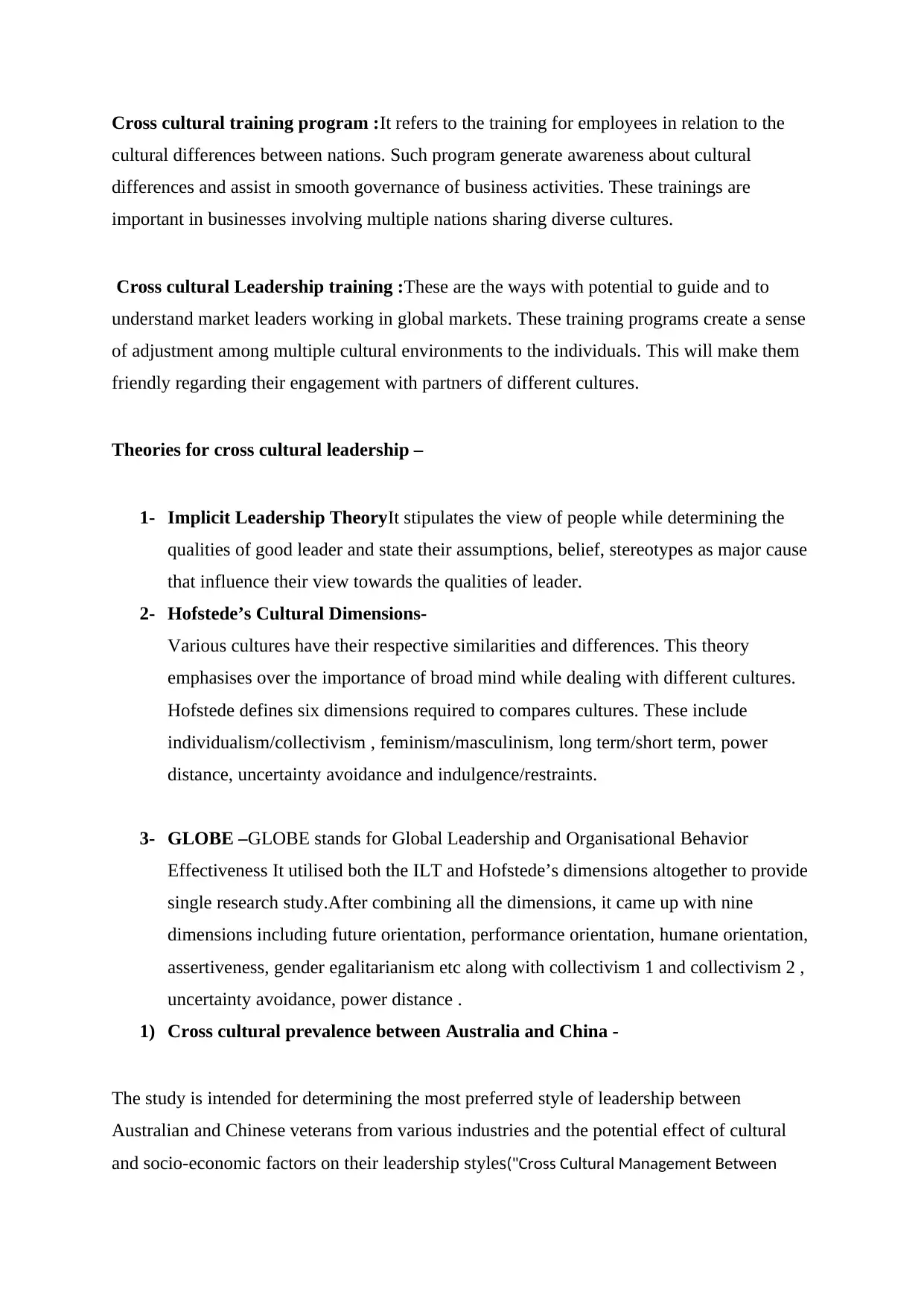
Cross cultural training program :It refers to the training for employees in relation to the
cultural differences between nations. Such program generate awareness about cultural
differences and assist in smooth governance of business activities. These trainings are
important in businesses involving multiple nations sharing diverse cultures.
Cross cultural Leadership training :These are the ways with potential to guide and to
understand market leaders working in global markets. These training programs create a sense
of adjustment among multiple cultural environments to the individuals. This will make them
friendly regarding their engagement with partners of different cultures.
Theories for cross cultural leadership –
1- Implicit Leadership TheoryIt stipulates the view of people while determining the
qualities of good leader and state their assumptions, belief, stereotypes as major cause
that influence their view towards the qualities of leader.
2- Hofstede’s Cultural Dimensions-
Various cultures have their respective similarities and differences. This theory
emphasises over the importance of broad mind while dealing with different cultures.
Hofstede defines six dimensions required to compares cultures. These include
individualism/collectivism , feminism/masculinism, long term/short term, power
distance, uncertainty avoidance and indulgence/restraints.
3- GLOBE –GLOBE stands for Global Leadership and Organisational Behavior
Effectiveness It utilised both the ILT and Hofstede’s dimensions altogether to provide
single research study.After combining all the dimensions, it came up with nine
dimensions including future orientation, performance orientation, humane orientation,
assertiveness, gender egalitarianism etc along with collectivism 1 and collectivism 2 ,
uncertainty avoidance, power distance .
1) Cross cultural prevalence between Australia and China -
The study is intended for determining the most preferred style of leadership between
Australian and Chinese veterans from various industries and the potential effect of cultural
and socio-economic factors on their leadership styles("Cross Cultural Management Between
cultural differences between nations. Such program generate awareness about cultural
differences and assist in smooth governance of business activities. These trainings are
important in businesses involving multiple nations sharing diverse cultures.
Cross cultural Leadership training :These are the ways with potential to guide and to
understand market leaders working in global markets. These training programs create a sense
of adjustment among multiple cultural environments to the individuals. This will make them
friendly regarding their engagement with partners of different cultures.
Theories for cross cultural leadership –
1- Implicit Leadership TheoryIt stipulates the view of people while determining the
qualities of good leader and state their assumptions, belief, stereotypes as major cause
that influence their view towards the qualities of leader.
2- Hofstede’s Cultural Dimensions-
Various cultures have their respective similarities and differences. This theory
emphasises over the importance of broad mind while dealing with different cultures.
Hofstede defines six dimensions required to compares cultures. These include
individualism/collectivism , feminism/masculinism, long term/short term, power
distance, uncertainty avoidance and indulgence/restraints.
3- GLOBE –GLOBE stands for Global Leadership and Organisational Behavior
Effectiveness It utilised both the ILT and Hofstede’s dimensions altogether to provide
single research study.After combining all the dimensions, it came up with nine
dimensions including future orientation, performance orientation, humane orientation,
assertiveness, gender egalitarianism etc along with collectivism 1 and collectivism 2 ,
uncertainty avoidance, power distance .
1) Cross cultural prevalence between Australia and China -
The study is intended for determining the most preferred style of leadership between
Australian and Chinese veterans from various industries and the potential effect of cultural
and socio-economic factors on their leadership styles("Cross Cultural Management Between

China And Australia | Bartleby", 2019). Under this, there was a research study over 500
participants from various industrial sectors, their employees, with the help of structured
questions in order to collect demographic and leadership style data. Under this research, it has
been recorded that the Chinese and Australian managers employee both the transformational
and transactions leadership styles. It also stated that usually Australian leaders prefer the
implications of transformational leadership as compared their Chinese counterparts.
Leadership styles are all related to age, sex, education and ethnicity as well. Transformational
leadership style, under the study is preferred by old and experienced person whereas new age
youth between 20-30 age ranges, willingly preferred transactional leadership style. Apart
from these, illiterate or less educated ones, preferred Laissez-faire Leadership style whereas
gender based leadership difference were unlikely to occur("How Does Laissez-Faire Leadership
Work?", 2019).
Among the various designs implemented, the primary design is related to qualitative
examination, which is a combination of participant observation of business meetings and
semi-structured interviews of senior managers and participant executives("Australia’s economic
relationships with China – Parliament of Australia", 2019). The research will also use case studies
of British subsidiary companies in China and Australia to evaluate the significance of cross
cultural business environment. Some of the primary questions of concerns in the study can be
mentioned as follows;
Can a critical analysis of dimensions of business meeting will be helpful for guiding
cross cultural management and communication?
What will be the description of dimensions of challenges in cross-cultural
communication and management?
What are the various factors that have potential to affect cross-cultural business
setting?
What are different strategies for effective cross-cultural communication management
to be used by experienced managers?
participants from various industrial sectors, their employees, with the help of structured
questions in order to collect demographic and leadership style data. Under this research, it has
been recorded that the Chinese and Australian managers employee both the transformational
and transactions leadership styles. It also stated that usually Australian leaders prefer the
implications of transformational leadership as compared their Chinese counterparts.
Leadership styles are all related to age, sex, education and ethnicity as well. Transformational
leadership style, under the study is preferred by old and experienced person whereas new age
youth between 20-30 age ranges, willingly preferred transactional leadership style. Apart
from these, illiterate or less educated ones, preferred Laissez-faire Leadership style whereas
gender based leadership difference were unlikely to occur("How Does Laissez-Faire Leadership
Work?", 2019).
Among the various designs implemented, the primary design is related to qualitative
examination, which is a combination of participant observation of business meetings and
semi-structured interviews of senior managers and participant executives("Australia’s economic
relationships with China – Parliament of Australia", 2019). The research will also use case studies
of British subsidiary companies in China and Australia to evaluate the significance of cross
cultural business environment. Some of the primary questions of concerns in the study can be
mentioned as follows;
Can a critical analysis of dimensions of business meeting will be helpful for guiding
cross cultural management and communication?
What will be the description of dimensions of challenges in cross-cultural
communication and management?
What are the various factors that have potential to affect cross-cultural business
setting?
What are different strategies for effective cross-cultural communication management
to be used by experienced managers?
⊘ This is a preview!⊘
Do you want full access?
Subscribe today to unlock all pages.

Trusted by 1+ million students worldwide
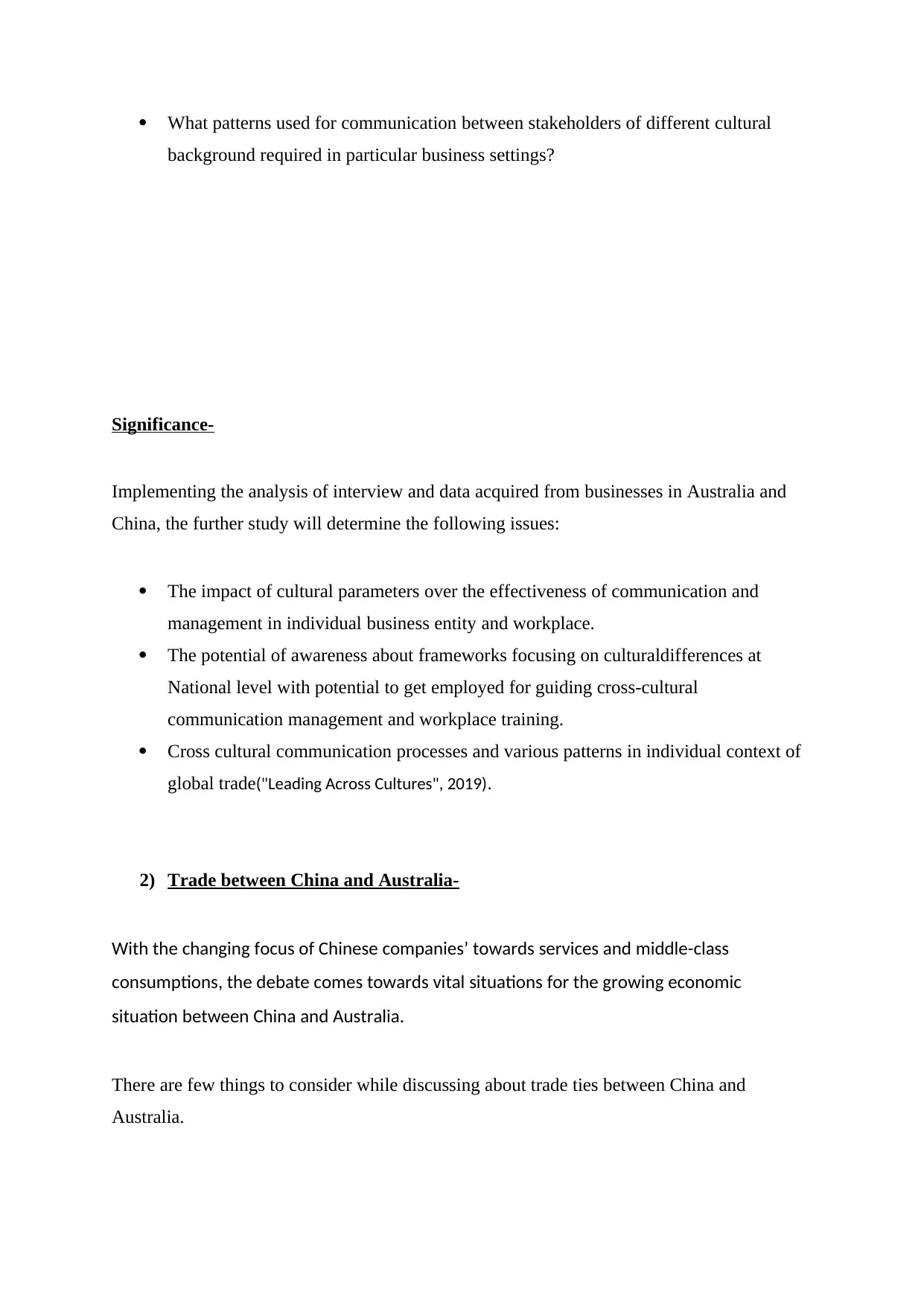
What patterns used for communication between stakeholders of different cultural
background required in particular business settings?
Significance-
Implementing the analysis of interview and data acquired from businesses in Australia and
China, the further study will determine the following issues:
The impact of cultural parameters over the effectiveness of communication and
management in individual business entity and workplace.
The potential of awareness about frameworks focusing on culturaldifferences at
National level with potential to get employed for guiding cross-cultural
communication management and workplace training.
Cross cultural communication processes and various patterns in individual context of
global trade("Leading Across Cultures", 2019).
2) Trade between China and Australia-
With the changing focus of Chinese companies’ towards services and middle-class
consumptions, the debate comes towards vital situations for the growing economic
situation between China and Australia.
There are few things to consider while discussing about trade ties between China and
Australia.
background required in particular business settings?
Significance-
Implementing the analysis of interview and data acquired from businesses in Australia and
China, the further study will determine the following issues:
The impact of cultural parameters over the effectiveness of communication and
management in individual business entity and workplace.
The potential of awareness about frameworks focusing on culturaldifferences at
National level with potential to get employed for guiding cross-cultural
communication management and workplace training.
Cross cultural communication processes and various patterns in individual context of
global trade("Leading Across Cultures", 2019).
2) Trade between China and Australia-
With the changing focus of Chinese companies’ towards services and middle-class
consumptions, the debate comes towards vital situations for the growing economic
situation between China and Australia.
There are few things to consider while discussing about trade ties between China and
Australia.
Paraphrase This Document
Need a fresh take? Get an instant paraphrase of this document with our AI Paraphraser
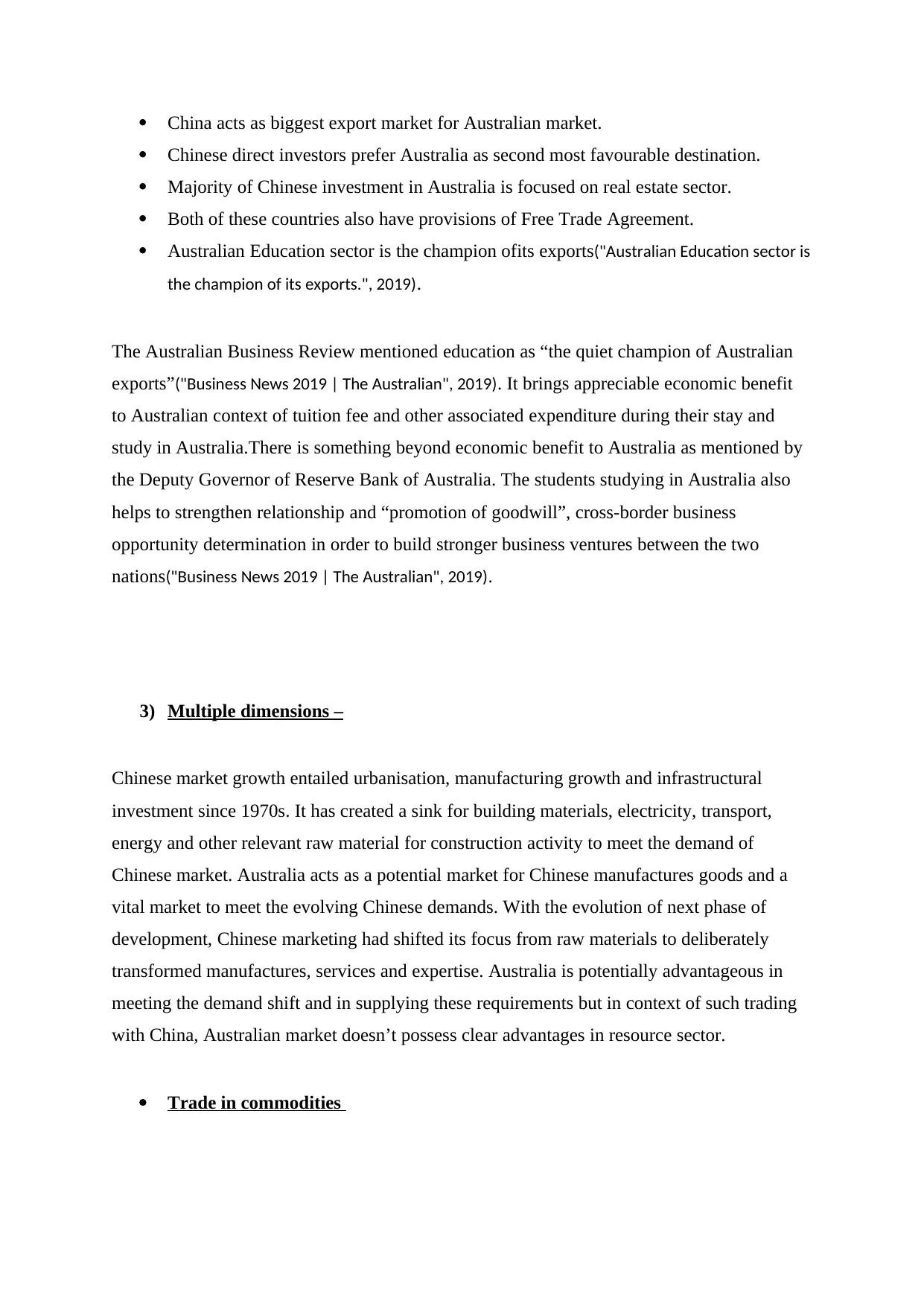
China acts as biggest export market for Australian market.
Chinese direct investors prefer Australia as second most favourable destination.
Majority of Chinese investment in Australia is focused on real estate sector.
Both of these countries also have provisions of Free Trade Agreement.
Australian Education sector is the champion ofits exports("Australian Education sector is
the champion of its exports.", 2019).
The Australian Business Review mentioned education as “the quiet champion of Australian
exports”("Business News 2019 | The Australian", 2019). It brings appreciable economic benefit
to Australian context of tuition fee and other associated expenditure during their stay and
study in Australia.There is something beyond economic benefit to Australia as mentioned by
the Deputy Governor of Reserve Bank of Australia. The students studying in Australia also
helps to strengthen relationship and “promotion of goodwill”, cross-border business
opportunity determination in order to build stronger business ventures between the two
nations("Business News 2019 | The Australian", 2019).
3) Multiple dimensions –
Chinese market growth entailed urbanisation, manufacturing growth and infrastructural
investment since 1970s. It has created a sink for building materials, electricity, transport,
energy and other relevant raw material for construction activity to meet the demand of
Chinese market. Australia acts as a potential market for Chinese manufactures goods and a
vital market to meet the evolving Chinese demands. With the evolution of next phase of
development, Chinese marketing had shifted its focus from raw materials to deliberately
transformed manufactures, services and expertise. Australia is potentially advantageous in
meeting the demand shift and in supplying these requirements but in context of such trading
with China, Australian market doesn’t possess clear advantages in resource sector.
Trade in commodities
Chinese direct investors prefer Australia as second most favourable destination.
Majority of Chinese investment in Australia is focused on real estate sector.
Both of these countries also have provisions of Free Trade Agreement.
Australian Education sector is the champion ofits exports("Australian Education sector is
the champion of its exports.", 2019).
The Australian Business Review mentioned education as “the quiet champion of Australian
exports”("Business News 2019 | The Australian", 2019). It brings appreciable economic benefit
to Australian context of tuition fee and other associated expenditure during their stay and
study in Australia.There is something beyond economic benefit to Australia as mentioned by
the Deputy Governor of Reserve Bank of Australia. The students studying in Australia also
helps to strengthen relationship and “promotion of goodwill”, cross-border business
opportunity determination in order to build stronger business ventures between the two
nations("Business News 2019 | The Australian", 2019).
3) Multiple dimensions –
Chinese market growth entailed urbanisation, manufacturing growth and infrastructural
investment since 1970s. It has created a sink for building materials, electricity, transport,
energy and other relevant raw material for construction activity to meet the demand of
Chinese market. Australia acts as a potential market for Chinese manufactures goods and a
vital market to meet the evolving Chinese demands. With the evolution of next phase of
development, Chinese marketing had shifted its focus from raw materials to deliberately
transformed manufactures, services and expertise. Australia is potentially advantageous in
meeting the demand shift and in supplying these requirements but in context of such trading
with China, Australian market doesn’t possess clear advantages in resource sector.
Trade in commodities
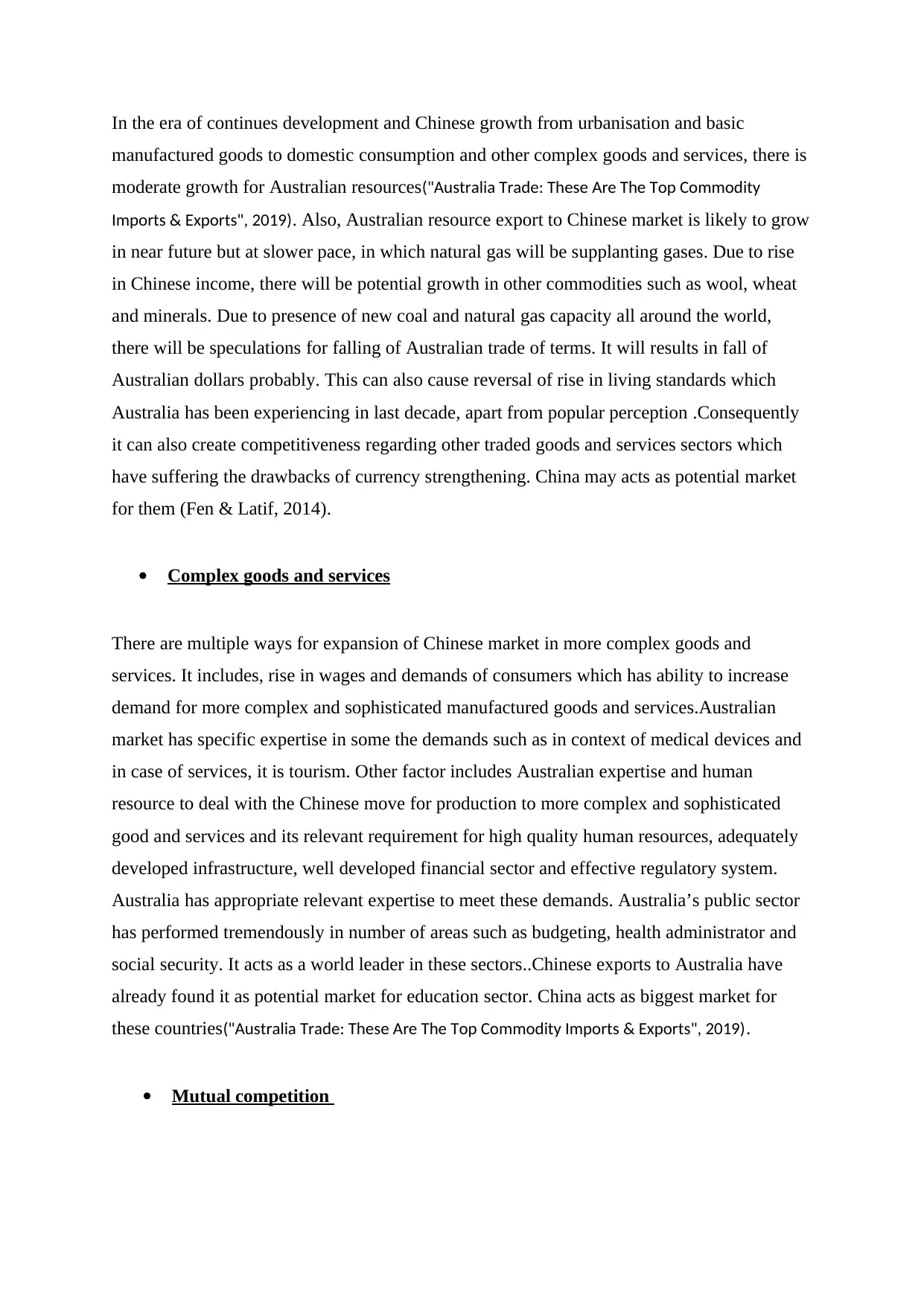
In the era of continues development and Chinese growth from urbanisation and basic
manufactured goods to domestic consumption and other complex goods and services, there is
moderate growth for Australian resources("Australia Trade: These Are The Top Commodity
Imports & Exports", 2019). Also, Australian resource export to Chinese market is likely to grow
in near future but at slower pace, in which natural gas will be supplanting gases. Due to rise
in Chinese income, there will be potential growth in other commodities such as wool, wheat
and minerals. Due to presence of new coal and natural gas capacity all around the world,
there will be speculations for falling of Australian trade of terms. It will results in fall of
Australian dollars probably. This can also cause reversal of rise in living standards which
Australia has been experiencing in last decade, apart from popular perception .Consequently
it can also create competitiveness regarding other traded goods and services sectors which
have suffering the drawbacks of currency strengthening. China may acts as potential market
for them (Fen & Latif, 2014).
Complex goods and services
There are multiple ways for expansion of Chinese market in more complex goods and
services. It includes, rise in wages and demands of consumers which has ability to increase
demand for more complex and sophisticated manufactured goods and services.Australian
market has specific expertise in some the demands such as in context of medical devices and
in case of services, it is tourism. Other factor includes Australian expertise and human
resource to deal with the Chinese move for production to more complex and sophisticated
good and services and its relevant requirement for high quality human resources, adequately
developed infrastructure, well developed financial sector and effective regulatory system.
Australia has appropriate relevant expertise to meet these demands. Australia’s public sector
has performed tremendously in number of areas such as budgeting, health administrator and
social security. It acts as a world leader in these sectors..Chinese exports to Australia have
already found it as potential market for education sector. China acts as biggest market for
these countries("Australia Trade: These Are The Top Commodity Imports & Exports", 2019).
Mutual competition
manufactured goods to domestic consumption and other complex goods and services, there is
moderate growth for Australian resources("Australia Trade: These Are The Top Commodity
Imports & Exports", 2019). Also, Australian resource export to Chinese market is likely to grow
in near future but at slower pace, in which natural gas will be supplanting gases. Due to rise
in Chinese income, there will be potential growth in other commodities such as wool, wheat
and minerals. Due to presence of new coal and natural gas capacity all around the world,
there will be speculations for falling of Australian trade of terms. It will results in fall of
Australian dollars probably. This can also cause reversal of rise in living standards which
Australia has been experiencing in last decade, apart from popular perception .Consequently
it can also create competitiveness regarding other traded goods and services sectors which
have suffering the drawbacks of currency strengthening. China may acts as potential market
for them (Fen & Latif, 2014).
Complex goods and services
There are multiple ways for expansion of Chinese market in more complex goods and
services. It includes, rise in wages and demands of consumers which has ability to increase
demand for more complex and sophisticated manufactured goods and services.Australian
market has specific expertise in some the demands such as in context of medical devices and
in case of services, it is tourism. Other factor includes Australian expertise and human
resource to deal with the Chinese move for production to more complex and sophisticated
good and services and its relevant requirement for high quality human resources, adequately
developed infrastructure, well developed financial sector and effective regulatory system.
Australia has appropriate relevant expertise to meet these demands. Australia’s public sector
has performed tremendously in number of areas such as budgeting, health administrator and
social security. It acts as a world leader in these sectors..Chinese exports to Australia have
already found it as potential market for education sector. China acts as biggest market for
these countries("Australia Trade: These Are The Top Commodity Imports & Exports", 2019).
Mutual competition
⊘ This is a preview!⊘
Do you want full access?
Subscribe today to unlock all pages.

Trusted by 1+ million students worldwide
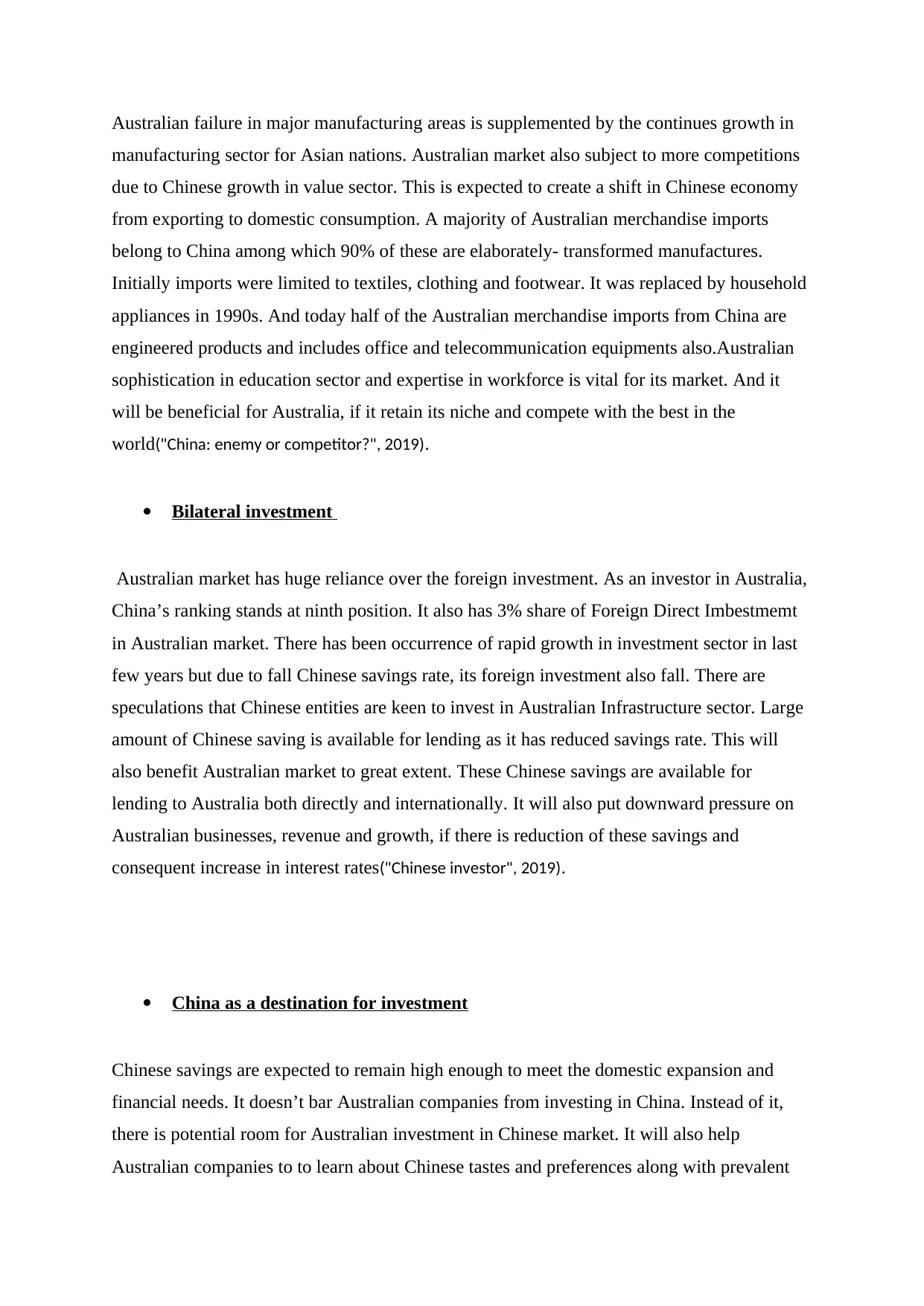
Australian failure in major manufacturing areas is supplemented by the continues growth in
manufacturing sector for Asian nations. Australian market also subject to more competitions
due to Chinese growth in value sector. This is expected to create a shift in Chinese economy
from exporting to domestic consumption. A majority of Australian merchandise imports
belong to China among which 90% of these are elaborately- transformed manufactures.
Initially imports were limited to textiles, clothing and footwear. It was replaced by household
appliances in 1990s. And today half of the Australian merchandise imports from China are
engineered products and includes office and telecommunication equipments also.Australian
sophistication in education sector and expertise in workforce is vital for its market. And it
will be beneficial for Australia, if it retain its niche and compete with the best in the
world("China: enemy or competitor?", 2019).
Bilateral investment
Australian market has huge reliance over the foreign investment. As an investor in Australia,
China’s ranking stands at ninth position. It also has 3% share of Foreign Direct Imbestmemt
in Australian market. There has been occurrence of rapid growth in investment sector in last
few years but due to fall Chinese savings rate, its foreign investment also fall. There are
speculations that Chinese entities are keen to invest in Australian Infrastructure sector. Large
amount of Chinese saving is available for lending as it has reduced savings rate. This will
also benefit Australian market to great extent. These Chinese savings are available for
lending to Australia both directly and internationally. It will also put downward pressure on
Australian businesses, revenue and growth, if there is reduction of these savings and
consequent increase in interest rates("Chinese investor", 2019).
China as a destination for investment
Chinese savings are expected to remain high enough to meet the domestic expansion and
financial needs. It doesn’t bar Australian companies from investing in China. Instead of it,
there is potential room for Australian investment in Chinese market. It will also help
Australian companies to to learn about Chinese tastes and preferences along with prevalent
manufacturing sector for Asian nations. Australian market also subject to more competitions
due to Chinese growth in value sector. This is expected to create a shift in Chinese economy
from exporting to domestic consumption. A majority of Australian merchandise imports
belong to China among which 90% of these are elaborately- transformed manufactures.
Initially imports were limited to textiles, clothing and footwear. It was replaced by household
appliances in 1990s. And today half of the Australian merchandise imports from China are
engineered products and includes office and telecommunication equipments also.Australian
sophistication in education sector and expertise in workforce is vital for its market. And it
will be beneficial for Australia, if it retain its niche and compete with the best in the
world("China: enemy or competitor?", 2019).
Bilateral investment
Australian market has huge reliance over the foreign investment. As an investor in Australia,
China’s ranking stands at ninth position. It also has 3% share of Foreign Direct Imbestmemt
in Australian market. There has been occurrence of rapid growth in investment sector in last
few years but due to fall Chinese savings rate, its foreign investment also fall. There are
speculations that Chinese entities are keen to invest in Australian Infrastructure sector. Large
amount of Chinese saving is available for lending as it has reduced savings rate. This will
also benefit Australian market to great extent. These Chinese savings are available for
lending to Australia both directly and internationally. It will also put downward pressure on
Australian businesses, revenue and growth, if there is reduction of these savings and
consequent increase in interest rates("Chinese investor", 2019).
China as a destination for investment
Chinese savings are expected to remain high enough to meet the domestic expansion and
financial needs. It doesn’t bar Australian companies from investing in China. Instead of it,
there is potential room for Australian investment in Chinese market. It will also help
Australian companies to to learn about Chinese tastes and preferences along with prevalent
Paraphrase This Document
Need a fresh take? Get an instant paraphrase of this document with our AI Paraphraser
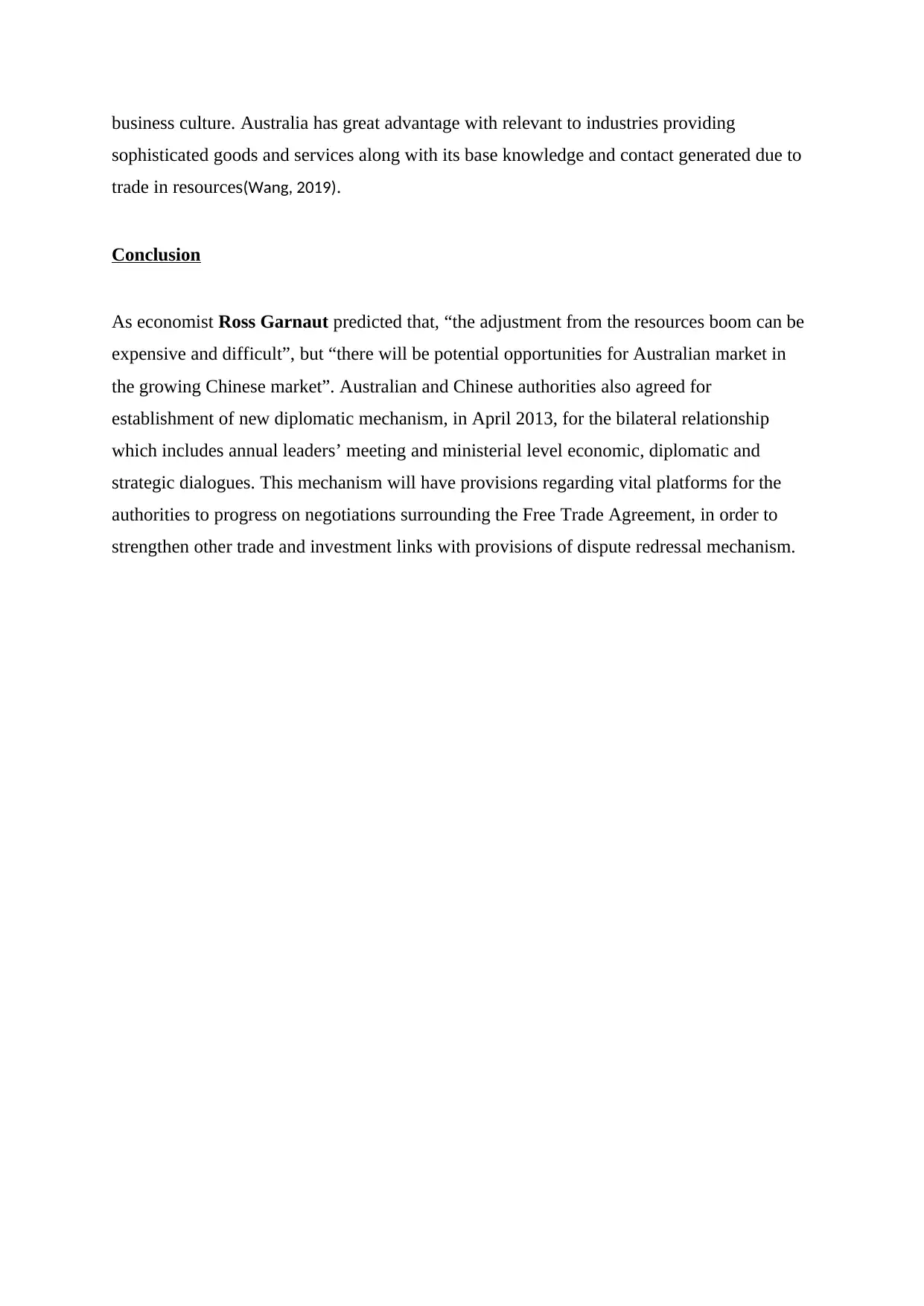
business culture. Australia has great advantage with relevant to industries providing
sophisticated goods and services along with its base knowledge and contact generated due to
trade in resources(Wang, 2019).
Conclusion
As economist Ross Garnaut predicted that, “the adjustment from the resources boom can be
expensive and difficult”, but “there will be potential opportunities for Australian market in
the growing Chinese market”. Australian and Chinese authorities also agreed for
establishment of new diplomatic mechanism, in April 2013, for the bilateral relationship
which includes annual leaders’ meeting and ministerial level economic, diplomatic and
strategic dialogues. This mechanism will have provisions regarding vital platforms for the
authorities to progress on negotiations surrounding the Free Trade Agreement, in order to
strengthen other trade and investment links with provisions of dispute redressal mechanism.
sophisticated goods and services along with its base knowledge and contact generated due to
trade in resources(Wang, 2019).
Conclusion
As economist Ross Garnaut predicted that, “the adjustment from the resources boom can be
expensive and difficult”, but “there will be potential opportunities for Australian market in
the growing Chinese market”. Australian and Chinese authorities also agreed for
establishment of new diplomatic mechanism, in April 2013, for the bilateral relationship
which includes annual leaders’ meeting and ministerial level economic, diplomatic and
strategic dialogues. This mechanism will have provisions regarding vital platforms for the
authorities to progress on negotiations surrounding the Free Trade Agreement, in order to
strengthen other trade and investment links with provisions of dispute redressal mechanism.
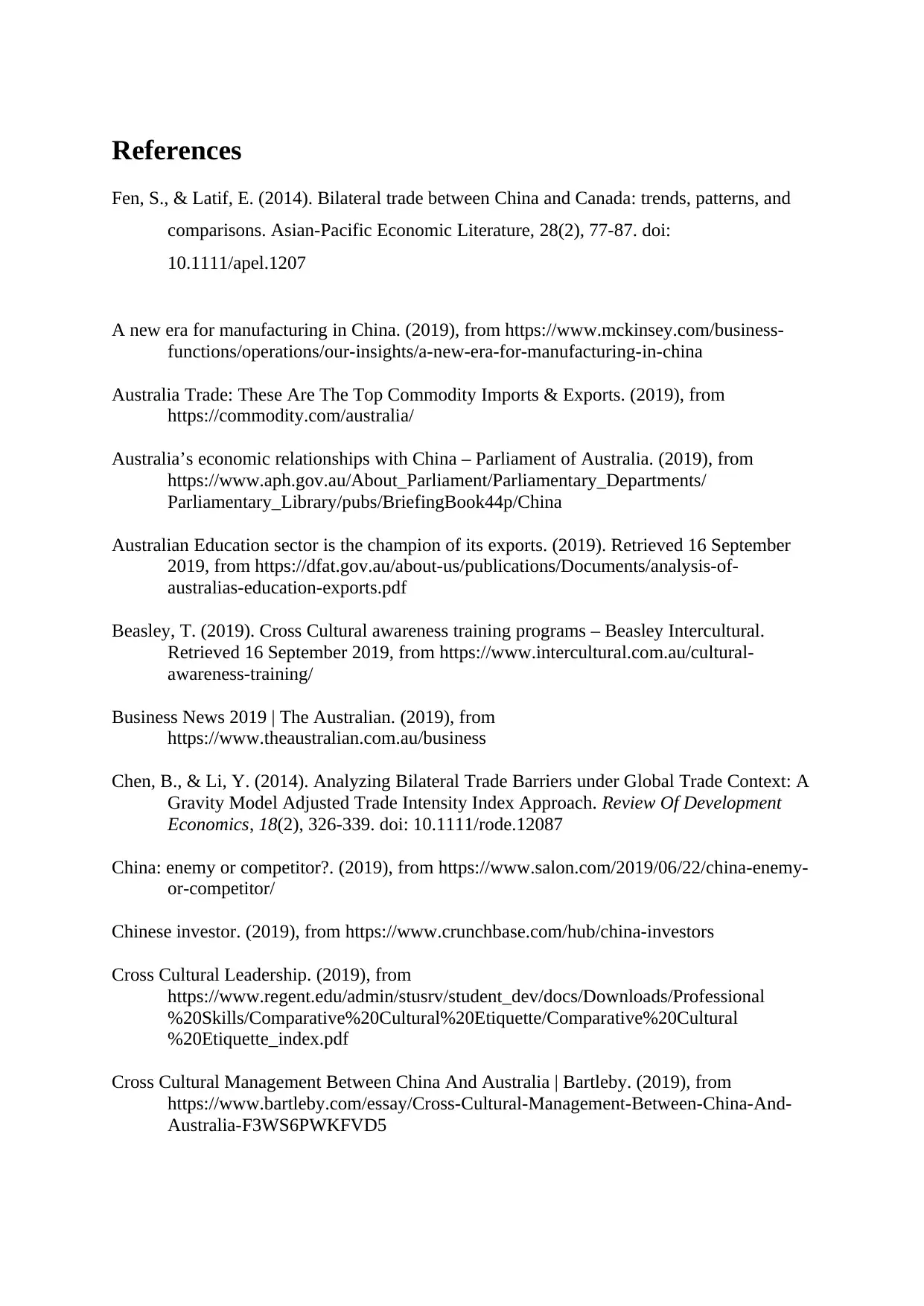
References
Fen, S., & Latif, E. (2014). Bilateral trade between China and Canada: trends, patterns, and
comparisons. Asian-Pacific Economic Literature, 28(2), 77-87. doi:
10.1111/apel.1207
A new era for manufacturing in China. (2019), from https://www.mckinsey.com/business-
functions/operations/our-insights/a-new-era-for-manufacturing-in-china
Australia Trade: These Are The Top Commodity Imports & Exports. (2019), from
https://commodity.com/australia/
Australia’s economic relationships with China – Parliament of Australia. (2019), from
https://www.aph.gov.au/About_Parliament/Parliamentary_Departments/
Parliamentary_Library/pubs/BriefingBook44p/China
Australian Education sector is the champion of its exports. (2019). Retrieved 16 September
2019, from https://dfat.gov.au/about-us/publications/Documents/analysis-of-
australias-education-exports.pdf
Beasley, T. (2019). Cross Cultural awareness training programs – Beasley Intercultural.
Retrieved 16 September 2019, from https://www.intercultural.com.au/cultural-
awareness-training/
Business News 2019 | The Australian. (2019), from
https://www.theaustralian.com.au/business
Chen, B., & Li, Y. (2014). Analyzing Bilateral Trade Barriers under Global Trade Context: A
Gravity Model Adjusted Trade Intensity Index Approach. Review Of Development
Economics, 18(2), 326-339. doi: 10.1111/rode.12087
China: enemy or competitor?. (2019), from https://www.salon.com/2019/06/22/china-enemy-
or-competitor/
Chinese investor. (2019), from https://www.crunchbase.com/hub/china-investors
Cross Cultural Leadership. (2019), from
https://www.regent.edu/admin/stusrv/student_dev/docs/Downloads/Professional
%20Skills/Comparative%20Cultural%20Etiquette/Comparative%20Cultural
%20Etiquette_index.pdf
Cross Cultural Management Between China And Australia | Bartleby. (2019), from
https://www.bartleby.com/essay/Cross-Cultural-Management-Between-China-And-
Australia-F3WS6PWKFVD5
Fen, S., & Latif, E. (2014). Bilateral trade between China and Canada: trends, patterns, and
comparisons. Asian-Pacific Economic Literature, 28(2), 77-87. doi:
10.1111/apel.1207
A new era for manufacturing in China. (2019), from https://www.mckinsey.com/business-
functions/operations/our-insights/a-new-era-for-manufacturing-in-china
Australia Trade: These Are The Top Commodity Imports & Exports. (2019), from
https://commodity.com/australia/
Australia’s economic relationships with China – Parliament of Australia. (2019), from
https://www.aph.gov.au/About_Parliament/Parliamentary_Departments/
Parliamentary_Library/pubs/BriefingBook44p/China
Australian Education sector is the champion of its exports. (2019). Retrieved 16 September
2019, from https://dfat.gov.au/about-us/publications/Documents/analysis-of-
australias-education-exports.pdf
Beasley, T. (2019). Cross Cultural awareness training programs – Beasley Intercultural.
Retrieved 16 September 2019, from https://www.intercultural.com.au/cultural-
awareness-training/
Business News 2019 | The Australian. (2019), from
https://www.theaustralian.com.au/business
Chen, B., & Li, Y. (2014). Analyzing Bilateral Trade Barriers under Global Trade Context: A
Gravity Model Adjusted Trade Intensity Index Approach. Review Of Development
Economics, 18(2), 326-339. doi: 10.1111/rode.12087
China: enemy or competitor?. (2019), from https://www.salon.com/2019/06/22/china-enemy-
or-competitor/
Chinese investor. (2019), from https://www.crunchbase.com/hub/china-investors
Cross Cultural Leadership. (2019), from
https://www.regent.edu/admin/stusrv/student_dev/docs/Downloads/Professional
%20Skills/Comparative%20Cultural%20Etiquette/Comparative%20Cultural
%20Etiquette_index.pdf
Cross Cultural Management Between China And Australia | Bartleby. (2019), from
https://www.bartleby.com/essay/Cross-Cultural-Management-Between-China-And-
Australia-F3WS6PWKFVD5
⊘ This is a preview!⊘
Do you want full access?
Subscribe today to unlock all pages.

Trusted by 1+ million students worldwide
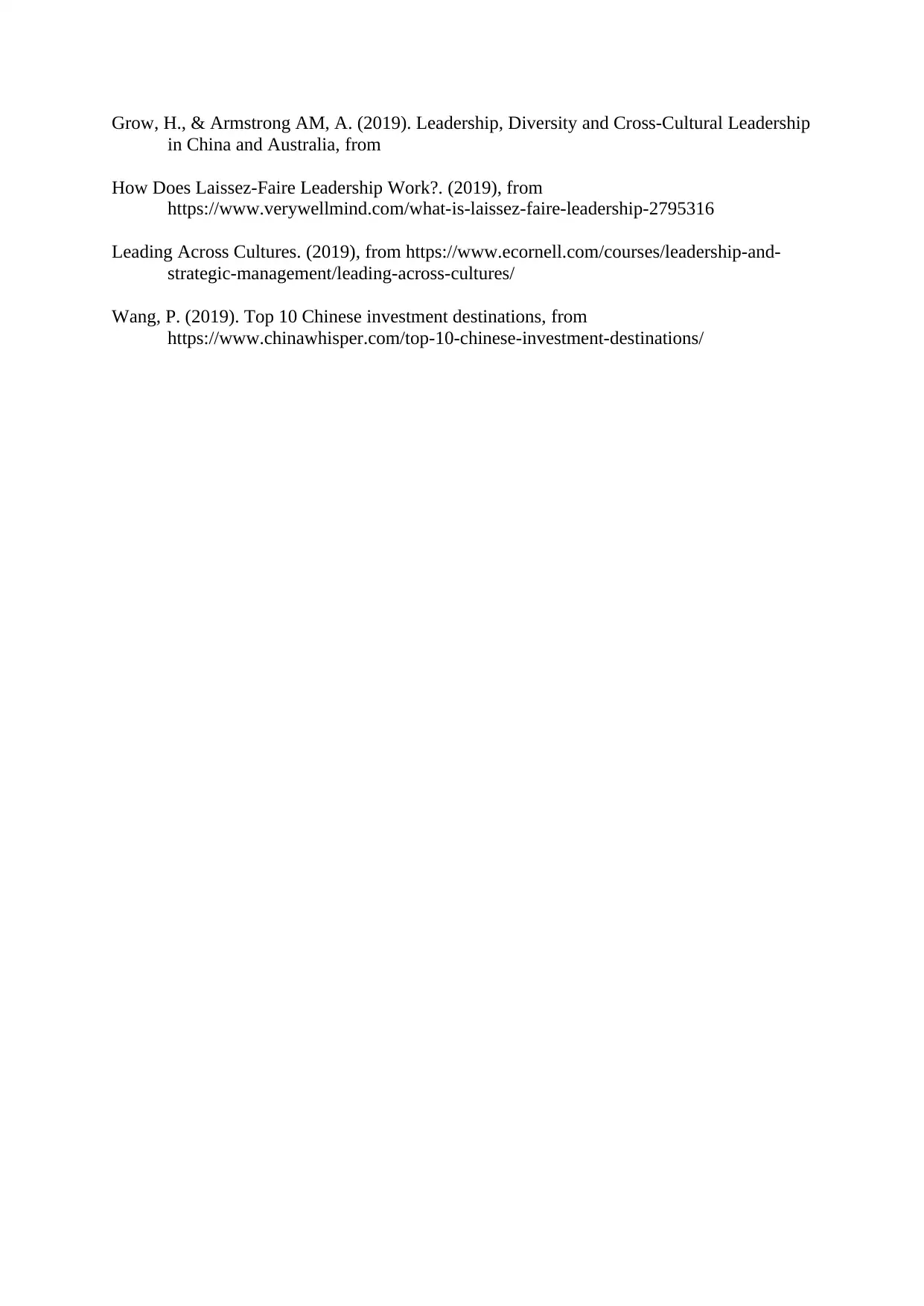
Grow, H., & Armstrong AM, A. (2019). Leadership, Diversity and Cross-Cultural Leadership
in China and Australia, from
How Does Laissez-Faire Leadership Work?. (2019), from
https://www.verywellmind.com/what-is-laissez-faire-leadership-2795316
Leading Across Cultures. (2019), from https://www.ecornell.com/courses/leadership-and-
strategic-management/leading-across-cultures/
Wang, P. (2019). Top 10 Chinese investment destinations, from
https://www.chinawhisper.com/top-10-chinese-investment-destinations/
in China and Australia, from
How Does Laissez-Faire Leadership Work?. (2019), from
https://www.verywellmind.com/what-is-laissez-faire-leadership-2795316
Leading Across Cultures. (2019), from https://www.ecornell.com/courses/leadership-and-
strategic-management/leading-across-cultures/
Wang, P. (2019). Top 10 Chinese investment destinations, from
https://www.chinawhisper.com/top-10-chinese-investment-destinations/
1 out of 10
Related Documents
Your All-in-One AI-Powered Toolkit for Academic Success.
+13062052269
info@desklib.com
Available 24*7 on WhatsApp / Email
![[object Object]](/_next/static/media/star-bottom.7253800d.svg)
Unlock your academic potential
Copyright © 2020–2025 A2Z Services. All Rights Reserved. Developed and managed by ZUCOL.




